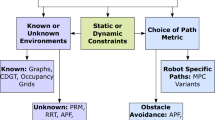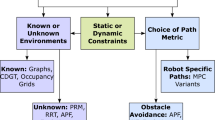Abstract
The quality of a path generated from an automated motion planning algorithm is of considerable importance, particularly when used in a real world robotic application. In this work a new path optimization algorithm, called the Adaptive Partial Shortcut algorithm, is presented. This algorithm optimizes paths as a post process to motion planning, and is designed specifically for use on industrial manipulators. The algorithm optimizes a robot’s degrees of freedom independently allowing it to produce manipulator paths of particularly high quality. This new algorithm utilizes an adaptive method of selecting the degree of freedom to optimize at each iteration, giving it a high level of efficiency. Tests conducted show the effectiveness of the algorithm; over a range of different test paths, the adaptive algorithm was able to generate solutions with a 60 % reduction in collision checks compared to the original partial shortcut approach.
Similar content being viewed by others
References
IFR: History of industrial robots - from the first installation until today. Milestones Technol Commer (2012)
Pan, Z., Polden, J., Larkin, N., Van Duin, S., Norrish, J.: Recent progress on programming methods for industrial robots. Robot. (ISR), 2010 41st Int. Symp. 28, 619–626 (2010)
Pan, Z., Polden, J., Larkin, N., Van Duin, S., Norrish, J.: Automated offline programming for robotic welding system with high degree of freedoms. Lect. Notes Electr. Eng. 121 LNEE, 685–692 (2011)
Kavraki, L.E., Svestka, P., Latombe, J.-C., Overmars, M.H.: Probabilistic roadmaps for path planning in high-dimensional configuration spaces, http://igitur-archive.library.uu.nl/math/2006-1216-202220/kavraki_94_probabilistic.pdf (1996)
Elbanhawi, M., Simic, M.: Sampling-based robot motion planning: a review. IEEE Access. 2, 56–77 (2014)
Guernane, R., Achour, N.: An algorithm for generating safe and execution-optimized paths. In: 2009 Fifth international conference on autonomic and autonomous systems, pp. 16–21. IEEE (2009)
Geraerts, R., Overmars, M.H.: Clearance based path optimization for motion planning. In: Proceedings. ICRA ’04. IEEE Int. Conf. Robot. Autom. 2004, p. 3 (2004)
Lin, H.-I.: A fast and unified method to find a Minimum-Jerk robot joint trajectory using particle swarm optimization. J. Intell. Robot. Syst. 75, 379–392 (2013)
Fragkopoulos, C., Graeser, A.: A RRT based path planning algorithm for Rehabilitation robots. In: 2010 41st International Symposium on Robotics (ISR), and 2010 6th German Conference on Robotics (ROBOTIK), pp. 1–8 (2010)
Sekhavat, S., Svestka, P., Laumond, J.-P., Overmars, M.H.: Multilevel path planning for nonholonomic robots using semiholonomic subsystems. Int. J. Rob. Res. 17, 840–857 (1998)
Kim, J., Pearce, R.A., Amato, N.M.: Extracting optimal paths from roadmaps for motion planning. In: 2003 IEEE International Conference on Robotics and Automation (Cat. no.03CH37422), pp. 2424–2429. IEEE (2003)
Nieuwenhuisen, D., Overmars, M.: Useful cycles in probabilistic roadmap graphs. In: Proceedings ICRA’04, IEEE international conference on robotics and automation, 2004, vol. 1, pp. 446–452. IEEE (2004)
Klasing, K., Wollherr, D., Buss, M.: Cell-based probabilistic roadmaps (CPRM) for efficient path planning in large environments. IEEE Int. Conf. Adv Robot (2007)
Guernane, R., Achour, N.: Generating optimized paths for motion planning. Rob. Auton. Syst. 59, 789–800 (2011)
Ratliff, N., Zucker, M., Bagnell, J.A., Srinivasa, S.: CHOMP: gradient optimization techniques for efficient motion planning. In: 2009 IEEE International Conference on Robotics and Automation, pp. 489–494. IEEE (2009)
Lin, C., Chang, P., Luh, J.: Formulation and optimization of cubic polynomial joint trajectories for industrial robots. IEEE Trans. Automat. Contr. 28, 1066–1074 (1983)
Isto, P.: Constructing probabilistic roadmaps with powerful local planning and path optimization. In: IEEE/RSJ international conference on intelligent robots and system, pp. 2323–2328. IEEE (2002)
Kallmann, M., Aubel, A., Abaci, T., Thalmann, D.: Planning Collision-Free reaching motions for interactive object manipulation and grasping. Comput. Graph. Forum. 22, 313–322 (2003)
Sanchez, G., Latombe, J.-C.: A single-query bi-directional probabilistic roadmap planner with lazy collision checking. In: Jarvis, R.A., Zelinsky, A. (eds.) Robotics research, pp. 403–417. Springer, Berlin (2003)
Guernane, R., Belhocine, M.: A smoothing strategy for PRM paths application to six-axes MOTOMAN SV3x manipulator. In: 2005 IEEE/RSJ international conference on intelligent robots and systems, pp. 4155–4160. IEEE (2005)
Hsu, D., Latombe, J.-C., Sorkin, S.: Placing a robot manipulator amid obstacles for optimized execution. In: Proceedings of the 1999 IEEE international symposium on assembly and task planning (ISATP’99) (Cat. no.99TH8470), pp. 280–285. IEEE (1999)
Stilman, M.: Global manipulation planning in robot joint space with task constraints. IEEE Trans. Robot. 26, 576–584 (2010)
Holleman, C., Kavraki, L.E.: A framework for using the workspace medial axis in PRM planners. In: Proceedings 2000 ICRA. Millennium Conference. IEEE International Conference on Robotics and Automation. Symposia Proceedings (Cat. No.00CH37065), vol. 2, pp. 1408–1413. IEEE (2000)
Del Pobil, A.P.: Guest editorial: Challenges in motion planning. J. Intell. Robot. Syst. Theory Appl. 38, 1–4 (2003)
Kannan, A., Gupta, P., Tiwari, R., Prasad, S., Khatri, A., Kala, R.: Robot motion planning using adaptive hybrid sampling in probabilistic roadmaps. electronics 5, 2 (2016)
Yuan, F., Liang, J., Fu, Y., Xu, H., Ma, K.: A hybrid sampling strategy with optimized probabilistic roadmap method. In: 12th international conference on fuzzy systems and knowledge discovery, vol. 2015, pp. 2298–2302 (2015)
Park, C., Rabe, F., Sharma, S., Scheurer, C., Zimmermann, U.E., Manocha, D.: Parallel cartesian planning in dynamic environments using constrained trajectory planning. In: 2015 IEEE-RAS 15th international conference on Humanoid robots (Humanoids), pp. 983–990. IEEE (2015)
Luna, R., Şucan, I.A., Moll, M., Kavraki, L.E.: Anytime solution optimization for sampling-based motion planning. In: 2013 IEEE international conference on robotics and automation (ICRA), pp. 5068–5074. IEEE (2013)
Zhao, R., Sidobre, D.: Trajectory smoothing using jerk bounded shortcuts for service manipulator robots. In: 2015 IEEE/RSJ international conference on intelligent robots and systems (IROS), pp. 4929–4934. IEEE (2015)
Author information
Authors and Affiliations
Corresponding author
Rights and permissions
About this article
Cite this article
Polden, J., Pan, Z., Larkin, N. et al. Adaptive Partial Shortcuts: Path Optimization for Industrial Robotics. J Intell Robot Syst 86, 35–47 (2017). https://doi.org/10.1007/s10846-016-0437-x
Received:
Accepted:
Published:
Issue Date:
DOI: https://doi.org/10.1007/s10846-016-0437-x




